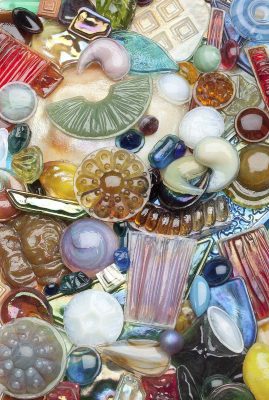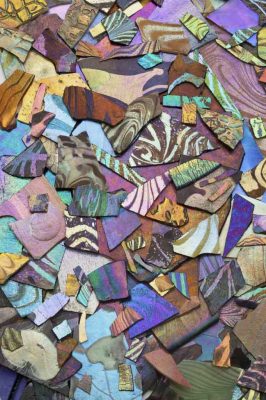
Racks of sheet glass used by Tiffany Studios.
The Neustadt Collection of Tiffany Glass, Queens, New York.
©The Neustadt Collection of Tiffany Glass, Queens, New York.
Tucked away in a nondescript warehouse in Queens, New York, is a library unlike any you’ve seen before. Carefully stored in towering aisles of wooden cubbies are more than a quarter of a million pieces of Tiffany glass in a seemingly endless array of rich colors, bold patterns, and intriguing textures. This “library” is the repository of a unique trove of original material once used by Louis C. Tiffany’s studios to create his celebrated leaded glass windows, lampshades, and mosaics. The Neustadt Collection of Tiffany Glass is its proud custodian.
When Tiffany’s firm closed in 1937, all remaining stock was sold. The liquidation sales included a vast inventory of flat glass, ranging from full, uncut sheets to shards the size of a fingernail, as well as a tantalizing assortment of glass “jewels” (pictured below left) Early Tiffany collector and museum founder Dr. Egon Neustadt (American, born Austria, 1898–1984) recognized the historical value of this material and purchased it in 1967. Today, this one-of-a-kind collection is an invaluable archive and offers important insights into Tiffany’s artistic legacy in glass.
As a museum renowned for its collection of Tiffany lamps and windows, The Neustadt explores and interprets the connections between its Glass Archive and these leaded-glass objects. But our collaboration with The Corning Museum of Glass on the exhibition and publication, Tiffany’s Glass Mosaics, provided an exciting opportunity to examine the archive through a new lens.
- Selection of glass “jewels,” about 1890-1920. Tiffany Furnaces, Corona, New York, and other glasshouses. The Neustadt Collection of Tiffany Glass
- Variety of iridescent glass used for mosaics, Tiffany Furnaces, Corona, New York. The Neustadt Collection of Tiffany Glass, Queens, New York.
The exhibition and publication spurred us to sift through our holdings of thousands of tiny pieces of glass that we had always suspected were used for mosaics. We found glass that was patterned and plain, textured and flat, iridescent and opalescent, opaque and translucent, some backed with gold leaf and others with aluminum leaf (pictured above right). And, among these shards, we were surprised and delighted to find hundreds of pieces of glass that had been painstakingly selected and cut into deliberate shapes, but for unknown reasons, never used. Some of these pieces even retain a wax residue, indicating that they were placed into a working composition for the artist to consider.

Mural, The Dream Garden, 1916. Tiffany Studios. Glass mosaic. Curtis Publishing Company Building (now The Curtis Center & Dream Garden); mural in the collection of Pennsylvania Academy of Fine Arts (2001.15, partial bequest of John W. Merriam; partial purchase with funds provided by a grant from The Pew Charitable Trusts; partial gift of Bryn Mawr College, The University of the Arts, and The Trustees of the University of Pennsylvania), Philadelphia, Pennsylvania. Photo: The Corning Museum of Glass, Corning, New York
Perhaps the most thrilling discoveries were made after visiting mosaic commissions across the U.S. and pouring over the new high resolution images of some of these sites captured by CMoG’s photography team. We successfully identified glass in our archive matching several of Tiffany’s most dazzling mosaics, including The Dream Garden, a resplendent 15- by 49-foot mosaic mural in Philadelphia based on a painting by American artist Maxfield Parrish. Glass made specially to translate Parrish’s distinctive color palette is featured in the exhibition, alongside a digital interactive exploring this monumental commission.

Detail of mural, The Dream Garden, 1916 (left). Tiffany Studios. Glass mosaic. Curtis Publishing Company Building (now The Curtis Center & Dream Garden); mural in the collection of Pennsylvania Academy of Fine Arts (2001.15, partial bequest of John W. Merriam; partial purchase with funds provided by a grant from The Pew Charitable Trusts; partial gift of Bryn Mawr College, The University of the Arts, and The Trustees of the University of Pennsylvania), Philadelphia, Pennsylvania.
Blown and cut glass murrine (right), Tiffany Furnaces, Corona, New York. The Neustadt Collection of Tiffany Glass, Queens, New York.
Photo: The Corning Museum of Glass, Corning, New York, Corning, New York
Sorting through thousands of unique examples, where no two are ever exactly alike, gave us a greater appreciation for the enormous task faced by Tiffany’s artisans at the start of each mosaic commission. From this seemingly endless variety of glass, choices had to be made. We faced a similar prospect as we agonized over which pieces to include in the exhibition. In the end, it took over 1,000 examples to even hint at the staggering range of possibilities. We hope this selection illuminates and reflects the artistic vision and persistence required to create these mosaic masterpieces.

Tiffany’s Glass Mosaics is on view at The Corning Museum of Glass May 20, 2017, through January 7, 2018. Learn more about the exhibition.


